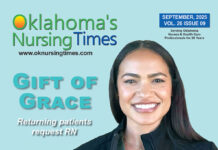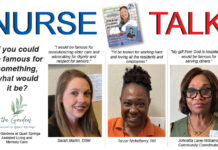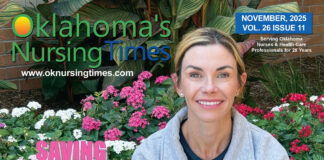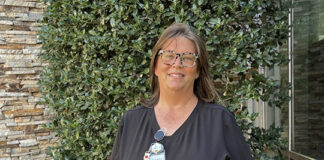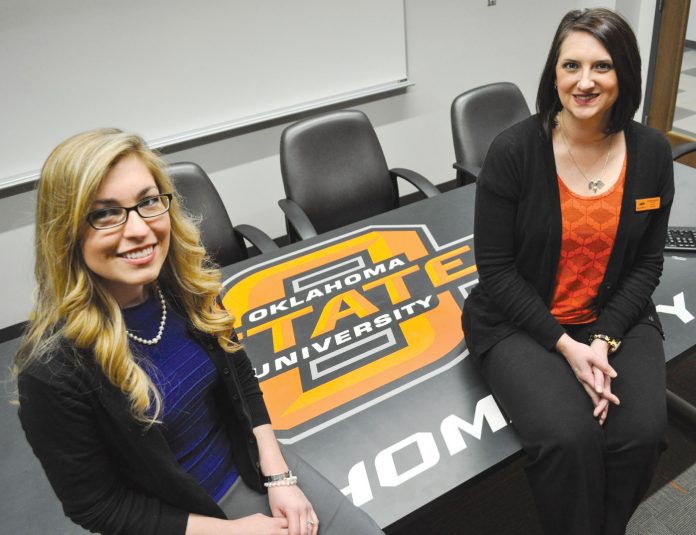
by Bobby Anderson
Staff Writer
At one point during nursing school, Emily Clark looked around and saw students all around her failing.
For Clark, that wasn’t OK.
“That really bothered me,” said Clark, MSN, RN and now a nursing science instructor at OSU-OKC.
So she gathered the struggling classmates, rewrote the material and then taught it herself.
Grades rose and so did Clark’s future aspirations.
“That’s when I figured out I liked to teach,” she said.
Her advisor talked her into getting her master’s right away even though bedside care was her immediate passion.
“I loved being a nurse, out there with the patients and I didn’t want to fully give that up yet,” she said. “I feel like I have the best of both worlds right now.”
Right now she works per diem at a local surgery/PACU unit and leads students full-time at OSU-OKC on the path to their nursing degree.
The majority of nursing faculty at OSU-OKC have a similar story about their love for education but their need to remain at the bedside.
It’s a common theme that binds them to their students.
“I approach nursing and teaching probably very similarly,” said Jennifer Downing, MSN, RN, nursing science instructor. “I’m really empathetic and compassionate with my patients and my students. A lot of nurses at my work work will say ‘you’ve been gone a long time. Where have you been.’ I tell them I’m with my patients, that’s what I’m here for.’”
“I’m like that with my students, too.”
Growing up in Indiana, Clark was the oldest of four children.
“I’ve always had that take-care-of-everybody attitude,” she said. “I think that’s part of why I like nursing so well because it’s a similar mentality. That applies to co-workers, students, patients. I think that’s what’s so nice about nursing. It’s very much a teamwork mentality.”
“Everybody works together and it just makes your day better.”
SCHOOL OF HARD KNOCKS
Nursing schools have historically been bombarded by complaints of disconnected, unsympathetic faculty long removed from patient care.
It’s the opposite at OSU-OKC.
“It’s very important,” Clark said of working nurses teaching. “What is the point of preparing them for something that doesn’t apply. Just as we try to teach our students to be holistic with their patients and not to see them as a checklist … as nursing instructors we need to make sure we carry that same holistic view into the world of instruction.”
“It’s not just ‘you’re the student, sink or swim, tough luck this is what we expect and here is the bar.’ It’s important to see them as a whole person.”
Clark and Downing agree that part of being a good instructor is not only being available for students but finding out what challenges they’re facing.
The post-conference sessions instructors have with students are important tools.
“It’s taking that time to talk to them about their day in an area where they feel safe in an area where they’re not worried about ‘what are the nurses hearing me say,’” Clark said. “You’re not being graded and they can just say ‘this is the emotional dilemma I’ve had today.’”
The funny thing is that OSU instructors can relate. They’ve been there before.
“I think we work well as a team and we do team-teaching here,” Downing said. “What I think we do really well for our students is connect with them on a personal level.”
Downing makes it a point to reach out to her students early each semester and supplies them with all her contact information including her cell.
She’s trying to reel that in.
“I make myself pretty available and they feel pretty comfortable contacting me – at all hours sometime,” Downing laughed. “I’m not very good at restricting that. I feel like I should be available to them. I love the connection we have with our students.”
Downing’s last 14 years have been spent as a labor room and delivery nurse, a role she still works at least four times a month.
“It helps having been there and still being there,” Clark said. “Time fades memories. Sometimes when I still work I have those days when I go home exhausted on every level mentally, emotionally and physically. It’s nice to still be able to know what our students are going through.”
“There’s not a right or wrong way to feel.”



